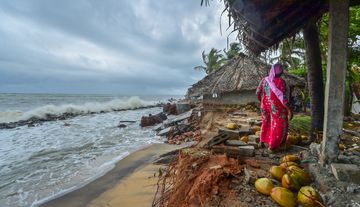India, being the third most affected country by climate-driven natural disasters, faces a unique set of challenges and opportunities in the realm of climate resilience. The country’s extensive coastline, home to a significant portion of its population, is particularly vulnerable. Rapid urbanisation, dense population centres, and economic activities along the coastline have heightened the risk of climate impact. Thus, balancing our efforts between adaptation and mitigation is not just necessary but time-sensitive, given the escalating climate crisis within our region.
Over 40 Indian cities are among the world’s most vulnerable to climate and environmental threats, highlighting the need for urgent action to safeguard these urban centres and their socio-economic contributions. Collectively, the nine coastal states attract over 60 per cent of India’s foreign direct investment, underscoring the importance of protecting them from climate-induced phenomena such as sea-level rise, flooding and cyclones.Over the next 50 years, India is poised to witness a dramatic shift in its demographic landscape, with projections indicating that more than 500 million people will inhabit urban areas. This translates to an astonishing rate of urban migration, where every minute, approximately 30 individuals move from rural to urban settings.
This paradigm shift necessitates integrated planning that encompasses not only the physical infrastructure but also the social and economic frameworks of urban areas. It calls for innovative solutions that enhance the sustainability and livability of cities, such as green buildings, efficient waste management systems, renewable energy sources, and water conservation practices. The rapid expansion of Indian cities, particularly those along the coast, urgently requires measures to make them disaster-resistant. Investing in low-carbon and climate-resilient infrastructure is crucial, with an estimated need of $700 billion for Indian urban areas from 2021 to 2031. This investment aims to mitigate climate risks, safeguard lives and livelihoods, and avert significant economic damages. Nature-based Solutions (NbS) are pivotal in this context, offering cost-effective and sustainable methods to enhance our environmental resources while tackling issues like climate change, poverty, and resource efficiency. These solutions not only contribute to disaster-risk reduction, carbon capture, reducing urban heat, enhancing water and food security, and improving public health but also prove economically beneficial by creating an average of seven to 40 jobs for every $1 million invested. NbS encompasses a wide range of applications, from small-scale projects like vertical gardens and green roofs to larger initiatives such as wetland conservation and mangrove restoration, demonstrating their versatility and significant impact on urban resilience.
The Indian government has recognised the importance of NbS, implementing various schemes to promote such interventions across cities. These include the Smart City Mission, AMRUT, the Nagar Van Scheme, Amrit Dharohar Yojana and MISHTI scheme among others. These low-cost, sustainable strategies not only address climate change and other societal challenges but also provide numerous benefits, including disaster risk reduction, carbon sequestration, and improved water resilience.
In the face of escalating climate challenges, Kerala stands at a critical juncture, necessitating urgent action to bolster its coastal and urban resilience. The state, known for its picturesque landscapes and rich biodiversity, is increasingly vulnerable to the adverse effects of climate change. With the largest coastline in western India, Kerala is home to millions of people who live in close proximity to the sea, making them particularly susceptible to the impacts of climate change. The Kerala government has already taken steps to promote NbS and climate-resilient infrastructure. Financing these climate-resilient initiatives, however, poses a significant challenge. With the global need for urban climate projects estimated at trillions of dollars, attracting climate finance requires clear strategies and engagement with the specific vulnerabilities of each region. Kerala must enhance transparency, accountability, and access to climate finance through simplified mechanisms and leveraging blended financing options.
India’s path to resilience involves tapping into both domestic and international capital, prioritising nature-based solutions, and ensuring community involvement at all levels. By focusing on climate-proofing infrastructure and enhancing access to finance and technology, India can build a sustainable and resilient future for its urban centres, especially those in coastal states, safeguarding the well-being of its people and the economy against the looming threats of climate change.
Author is G20 Sherpa. He is ex-CEO, NITI Aayog.


